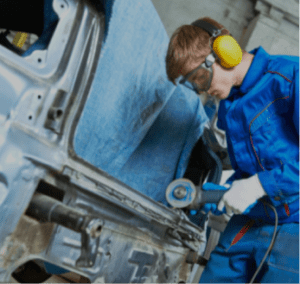There come unfortunate events in life which you cannot sometimes avoid, like getting in a car accident. There are a lot of aspects that needed to be taken care of after the accident. It is based on the intensity of the collision. While some accidents of the lower severity can only leave superficial damages, some accidents can cause larger damages than imagined.
To know if your vehicle’s frame has been damaged to a point where it needs repairing, keep reading to learn some tips. Not only do these tips account to getting into an accident, but you can also check for these considerations before buying a car:
● A VISUAL LEAN OR TILT:
Check to see if your car has a visual tilt or a lean, the best way is to park it over a flat surface – ideally on a surface that features bright and fine lines. Once your car is parked in the parking lot, step back a few steps, and view the vehicle properly.
You can now see and decide for yourself if your car is slightly leaning on the right or the left, or if the front wheels do not seem to be in line with the rear wheels. If one of them is the case, there is a high chance that your vehicle has frame damage or some fault that is not visible.
● STUCK DOORS:
One of the finest features of a newly manufactured vehicle is that every aspect of the car fits together tightly. Although the gap between the doors isn’t much, they are designed in a way that shouldn’t let them bump, stick, or rub upon opening.
Open every vehicle door and check for any rubbing or bumping upon opening, or if they are challenging to open. If the doors are cleared, look at the hood and the trunk of the car by doing the same. Usually, when the hinged parts of your vehicle do not work that well, there is a chance that your vehicle has frame damage and needs to go to a body shop.
● MISALIGNED GAPS:
While you are checking for hinged devices, take a look at the trunk, hood, and doors of the car for unnoticeable gaps as well. While the gaps are important for everything to open nicely, make sure that they are fairly even at the same time. Such as the gap on the driver’s side of the hood should be equal to the gap on the passenger’s side hood, and the same goes for the doors on either side.
One way to check if your frame is damaged is by checking if the doors of the car are uneven. It is evident enough that the part of the car that was hit in an accident will be uneven. If your car has been struck from the back, and the gaps of your hood have become uneven, there is a chance that the damage has rippled to the front of the car.
● WHEEL ALIGNMENT:
The easiest way to see if your newly bought car has an underlying problem is to get the wheels of your car aligned. Whether it is your car getting into everyday bumps on regular driving, or getting into an accident, the wheels of your car will need an alignment, as they can go off Kilter.
However, a particular car with frame damage will be more difficult to align. So, if the previous owner of your car hasn’t disclosed everything about the vehicle, check for the car’s wheel alignment. However, the alignment of your car certainly does not go out only after getting into an accident.




